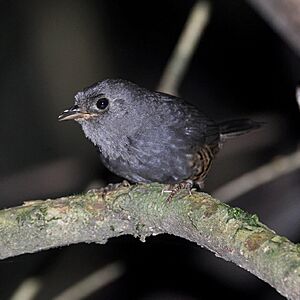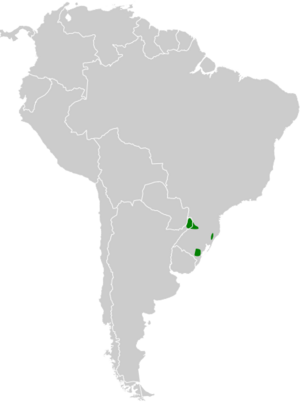Planalto tapaculo facts for kids
Quick facts for kids Planalto tapaculo |
|
|---|---|
 |
|
| Conservation status | |
| Scientific classification | |
| Genus: |
Scytalopus
|
| Species: |
pachecoi
|
 |
|
The Planalto tapaculo (say "pla-NAL-toh ta-pa-KOO-loh") is a small, shy bird. It belongs to a family of birds called Rhinocryptidae, known as "tapaculos." You can find this little bird in the forests of southeastern Brazil and the very northeast part of Argentina.
Contents
Discovering the Planalto Tapaculo
For a while, scientists thought the Planalto tapaculo was the same as another bird. This other bird is called the mouse-colored tapaculo. But in 2005, scientists looked closely at the Planalto tapaculo. They noticed its feathers were different. Its songs and calls were also unique. Because of these differences, they decided it was a brand new species! The bird's scientific name, Scytalopus pachecoi, honors Fernando Pacheco. He is a famous bird scientist from Brazil.
What Does the Planalto Tapaculo Look Like?
The Planalto tapaculo is a small bird. It is about 12 cm (4.7 in) (about 5 inches) long. It weighs around 15 g (0.53 oz) (about half an ounce). That's about the weight of three quarters!
Male and Female Birds
Male Planalto tapaculos are mostly dark gray on their backs. Their bellies are a lighter gray. Their sides have buff (light brownish-yellow) feathers with dark stripes. These stripes help tell them apart from the mouse-colored tapaculo. The mouse-colored tapaculo does not have these stripes. Female Planalto tapaculos are a bit browner than the males. Young Planalto tapaculos have not been fully described yet.
Where Does the Planalto Tapaculo Live?
This bird lives in southern Brazil. You can find it in parts of Rio Grande do Sul and southeastern Santa Catarina. It also lives in the very northeast part of Misiones Province in Argentina.
Planalto Tapaculo's Home
The Planalto tapaculo likes to live in forests. It also lives at the edges of forests. You can often find it near small streams. It likes to hide in thick bushes, especially bamboo patches. Scientists have found more of these birds in forests that have grown back after being cut down. They can live in places up to 1,500 m (4,900 ft) (about 4,900 feet) high.
How the Planalto Tapaculo Behaves
What the Planalto Tapaculo Eats
The Planalto tapaculo is a busy little hunter. It looks for small bugs and other arthropods. It searches for its food in the undergrowth of the forest. This means it looks on the ground and in low plants. It especially likes to search in thick patches of bromeliads (plants like pineapples) and bamboo.
Planalto Tapaculo Reproduction and Life Cycle
Scientists don't know much about how the Planalto tapaculo raises its young. One nest was found in Argentina in September. It had two eggs inside. But there aren't many details about the nest itself.
Planalto Tapaculo's Voice
The Planalto tapaculo has a special song. It starts with notes that are slow, about two or three per second. Then, the notes get faster and faster. It turns into a long, fast trill. You can listen to an example of its song online [1]. The mouse-colored tapaculo's song is faster, with about five notes per second. The Planalto tapaculo also has a clear, single-note call it uses to talk to other birds. It also has a loud call it uses when it senses danger.
Is the Planalto Tapaculo Safe?
The IUCN (International Union for Conservation of Nature) checks on animals around the world. They have said the Planalto tapaculo is a species of "Least Concern." This means it is not currently in danger of disappearing. Even though it lives in a small and spread-out area, it lives in several protected places. Also, it seems to do well in forests that have been disturbed or are growing back.


